Human Flower Project
Friday, April 18, 2008
In Iris Society, ‘It’s What You Like’
Dishwater blondes, clowns and upturned beards, the American Iris Society has seen it all.
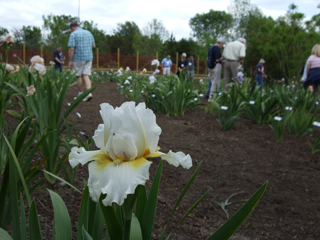
Members of the American Iris Society, in Austin, Texas
for their annual meeting, toured the mammoth iris bed
at the Natural Gardener on April 17, 2008
Photo: Human Flower Project
Peachy, icy, frilly – and then there’s the one that looks like a grimy t-shirt.
Iris fanciers must be the most broadminded of all floral enthusiasts, because there’s a greater range among the flowers they breed, grow and travel cross country to see than any flower–type we know.
You orchid people may take issue. But who has seen a two-tone brown orchid? Who’s bred one the color of rag and named it “Ugly Duckling”? We saw Ugly Duckling and many fairer species with our own eyes yesterday, tagging along with the experts as the American Iris Society descended on Austin for its annual weeklong convention.
Miracles of azure, crystal puffs and mongrels in several shades of tinkle-yellow…what a range of color! Shapes too. We saw iris blooms delicate as meringues and others like smashed pinwheels, enough to make a small child cry. Much to their credit, the iris people seem to enjoy them all. Here was one the color of a puddle. “You either like it or you don’t,” Jim Morris of St. Louis told me. “I like it.”
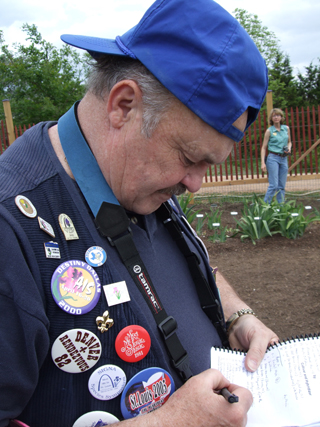 Jim Morris of St. Louis, an iris grower since childhood and veteran of many meetings—thus the badges—took notes on the flowers Thursday; the year’s winning iris will be announced Sunday, April 20
Jim Morris of St. Louis, an iris grower since childhood and veteran of many meetings—thus the badges—took notes on the flowers Thursday; the year’s winning iris will be announced Sunday, April 20
Photo: Human Flower Project
There have been lectures, judges training sessions, and classes for the 430 participants, but the highlight, as at every iris convention, has been the garden visits, seven in all. Thursday, April 17, the group bussed west of the city to the Natural Gardener, one of Austin’s premier nurseries, to check out the 800-plus varieties that have been grown in the big full-sun bed made just for them.
Convention locales are decided at least two years in advance. That way, breeders can send their rhizomes ahead to be planted and get established so that by meeting time, if all goes well, they’ll be in full, healthy flower.
Some of the irises had “bloomed out” before the AIS members arrived. Other plants were still a just few green blades, but scores more were performing well. Jim Morris, who’s raised irises since childhood, was taking careful notes, as were many others. On Sunday evening, all the convention-goers will cast ballots for the best flowers they’ve seen this week.
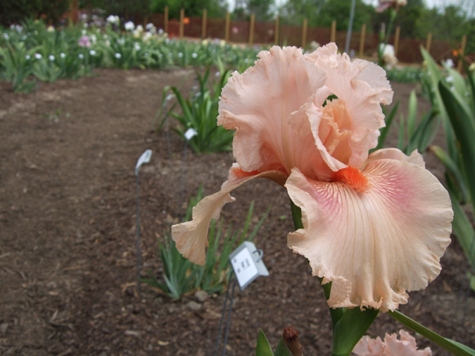
Augustine, a bearded iris (non-space age) bred by O. Schick, 2005
Photo: Human Flower Project
Barbara Sautner, president of the Iris Society of Minnesota, explained that judges look for “branching, bud count, and growth.” (To our surprise and chagrin, fragrance doesn’t matter.) Sautner, and many others, too, lingered by an unnamed seedling, AM0010550-3, bred by Anton Mego of Slovakia. These are new varieties that have yet to be introduced to the market. “They want to see if we like it,” said Patricia Wurtele, of Ramona, California. From all the eye-bugging and finger-pointing, Mego’s tall purple, yellow and red iris is a winner, and for a $15 registration fee, will get a name. Since this lilting three-tone iris had thrived here in Texas, how about “Jimmie Dale Gilmore”?
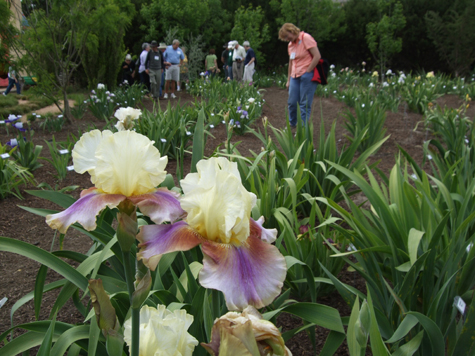
A successful seedling, as yet unnamed, from Slovakian hybridizer Anton Mego
Photo: Human Flower Project
Sautner said that several of the nation’s biggest iris companies are located near Portland; Schreiner is in Oregon today, though it began in the 1920s in Minnesota. “They started bringing in iris from France and the Mediterranean that couldn’t survive our winters,” she explained. So the big hybridizers eventually moved west.
We’d never thought of Central Texas as iris land (not like back in Kentucky). Skimpy white “flags” are among the earliest flowers here in Austin, often blooming in mid-February and spent a week later. We have some pretty, but also frail, passalong purples that flower in March. And our neighbors David and Wendy Todd have many tall Louisiana iris, bright yellow, now blooming around their pond.
But the huge bearded hybrids these iris experts most admire are Bouvier des Flandres compared with our local fidos. There are double scoops of sorbet – like the aptly named Trinotostare. And the iris socialites appear to be especially taken with “space age” varieties. These irises, Richard Wurtele told us, were introduced over the past ten years and bred with weird beards. Rather than hanging down, a little bristle down the center of the iris “fall,” these beards are flexed into “horns, spoons and flounces.”
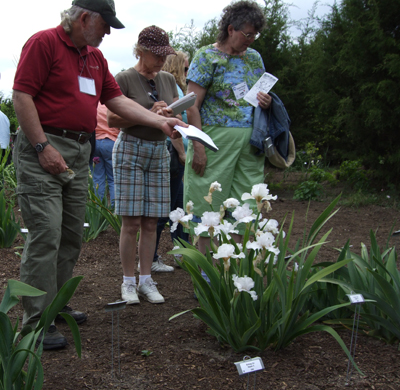
Hybridizer Jack Worel talks to Jean Morris and Barbara Sautner about
his Silver Creek iris, which has taken to Central Texas beautifully
Photo: Human Flower Project
Jack Worel, from Osseo, Minnesota, said that hybridizing iris is fairly easy (Note: Jack may be at a genetic advantage—his great aunt Elsie Peterson was one of the first iris judges in the U.S.). On Thursday his Silver Creek, a white iris with a deep orange beard, drew a crowd. “Wow, what a clump!” exclaimed Jean Morris of Baldwin, Missouri, as she scribbled in a notebook. Jack said that Silver Creek is the offspring of Michelle Taylor, another white iris, and Shirley M, pink with a blue beard. Loaded with cigar like buds and rippling blooms, it seems to like it here in Austin.
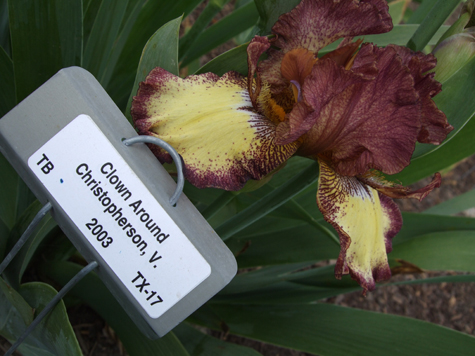
A “space age” iris with upturned beard and plicata (speckles)
Photo: Human Flower Project
After encountering Worel’s beautiful white iris, as well as Hurry Up Sun, Augustine, and Full Figured, we will have to give bearded iris a try. Patricia Wurtele says these spectacular hybrids aren’t hard to grow, so long as they’re shallowly planted and receive a half day of sun. They do like water (a problem here) and good drainage. “And they’re hungry flowers,” she says, recommending alfalfa pellets to enrich the soil.
But just because a hybridizer can concoct an iris with a red, spoon-shaped beard that sticks two inches in the air, does anyone want one? Apparently so. “It’s what you like,“ Jim Morris says serenely. We like Jimmie Dale Gilmore.
Culture & Society • Gardening & Landscape • Secular Customs • Travel • Permalink




